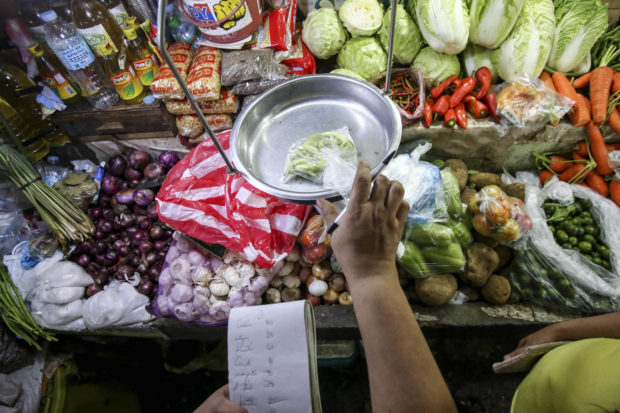ADB: PH annual inflation to hit 6-year high of 4.3% in 2018

INQUIRER PHOTO/ JAM STA ROSA
The Asian Development Bank sees local consumer prices staying elevated for the rest of the year such that it projected inflation to average of at least six-year high of 4.3 percent in 2018 and breach the government’s target range.
In its Asian Development Outlook Supplement July 2018 report released Thursday, the Manila-based multilateral lender raised its 2018 inflation outlook for the Philippines from 4 percent in the earlier Asian Development Outlook 2018 report last April.
To compare, inflation averaged 2.9 percent last year, 1.3 percent in 2016, 0.7 percent in 2015, 3.6 percent in 2014, and 2.6 percent in 2013, based on 2012 prices.
“Inflation in the Philippines reached 5.2 percent in June, driven largely by price hikes for fuel and related items and by sporadic shortages of key food items. This outcome combines with expectedly high global oil prices, peso depreciation, and strong domestic demand to prompt this supplement to revise the inflation forecast for 2018,” the ADB explained.
Last month’s headline inflation hit a fresh over five-year high, such that the first-half rate stood at 4.3 percent, already breaching the full-year target range of 2-4 percent.
Article continues after this advertisement“Higher excise taxes on fuel and some commodities as part of the Tax Reform for Acceleration and Inclusion Act, which took effect in January 2018, are contributing factors,” the ADB said, referring to the TRAIN Law.
Article continues after this advertisementSigned by President Duterte last December, the TRAIN Law or Republic Act No. 10963 since Jan. 1 this year jacked up or imposed new excise taxes on cigarettes, sugary drinks, oil products and vehicles, among other goods, to compensate for the restructured personal income tax regime that raised the tax-exempt cap to an annual salary of P250,000.
Due to higher-than-expected inflation, the Bangko Sentral ng Pilipinas’ policymaking Monetary Board already hiked the policy rate to 3.5 percent or by 25 basis points each in May and June.
For next year, the ADB kept its inflation forecast of 3.9 percent as “the impact of tax reform on inflation is expected to be transitory and normalize in 2019.”
“Also arguing for maintaining the inflation forecast for 2019 are upward adjustments to monetary policy rates anticipated in line with tightening monetary policy globally,” the ADB added.
The BSP is seen again hiking interest rates at its next policy meeting in August.
Early this month, economic managers conceded that inflation would exceed the upper end of the government target for 2018, such that they adopted the BSP’s forecast of 4-4.5 percent for the entire year.
While keeping the 2-4 percent inflation target for the period 2018-2020, the Cabinet-level Development Budget Coordination Committee (DBCC) jacked up their projected rate of increase in prices of basic goods for this year from the earlier forecast of 2-4 percent during their previous meeting in April.
For the period 2019-2022, the yearly inflation forecasts were maintained at 2-4 percent.
Economic managers nonetheless expect the rate of increase in prices of basic goods to taper off in the second half, as global oil prices, as well as local rice prices were expected to stabilize towards yearend.